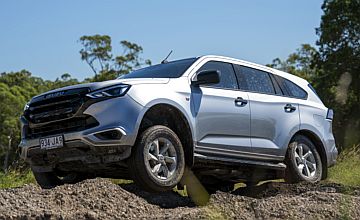2024 Isuzu MU-X Review

Overview
IN THE wake of rising fuel prices, Isuzu Ute Australia has launched a new small-capacity turbo-diesel engine option, which is set to bring fuel savings and lower emissions.
Following in the footsteps of its nearest competitor, the Ford Everest, Isuzu has introduced a smaller, more economical diesel engine to the MU-X line-up and with that comes a cheaper entry-level price.
The 1.9-litre turbo-diesel engine now offered in certain MU-X models has been used extensively in overseas markets for the past five-or-so years, proving itself as a reliable option. However, it does come with a significant power deficit.
Compared with the 3.0-litre diesel engine, which produces 140kW/450Nm, the smaller 1.9-litre donk settles for 110kW/350Nm – which is a noticeable drop in torque.
For that drop, buyers will save $2000 on the purchase price while also getting combined fuel economy in the vicinity of 7.4 litres per 100km against the larger engine’s claimed 8.3L/100km. We’ve tested both engines in D-Max models, and the figures are fairly accurate.
Both engines run through the same proven Aisin-sourced six-speed automatic transmission, although the 1.9-litre engine scores a shorter final drive, helping it ever so slightly against its gruntier counterpart.
The appeal of the smaller engine is likely to make sense for savvy shoppers and fleet buyers, looking to squeeze value out of not only a lower drive-away price but fuel-use savings too.
Despite now offering a cheaper, smaller engine option, the entire MU-X range faces a price increase of between $500 and $2000 – somewhat offset by the cheaper entry-level models. The top-of-the-range LS-T 4x4 keeps its longstanding $67,990 drive-away price, though, which is surprising given it now features even more tech’.
“Increasing the price of the 24MY MU-X range was a decision not taken lightly, with all options deeply considered,” said Isuzu Ute Australia managing director Junta Matsui at the Australian launch.
“We’re confident that value for money has been maintained across the 24MY MU-X range and the addition of the 1.9-litre turbo-diesel engine gives customers a more affordable option – not just in the showroom, but down the track as it is up to 10 per cent more fuel-efficient than our 3.0-litre engine.”
In terms of real-world practicality, the MU-X fitted with the 1.9-litre engine gets a reduced towing capacity of 3000kg against the 3.0-litre option’s 3500kg, but gains payload with the lighter engine leaving more of its 2800kg GVM in the tank.
A relatively basic infotainment display and interface remains in MU-X models.
Isuzu still offers the same six-year/150,000km warranty remain, with up to seven years of roadside assist and five-year capped price servicing across the range.
Visually, the aesthetics are the same as the previous model year, but with the new powertrain offering more choice and efficiency, it does add more appeal for some.
We deliberately beelined for the 1.9 LS-M 4x4 at the official media launch, to get a feel for the cheapest off-road ready wagon Isuzu offers and to see if it stacks up in the real world.
Driving Impressions
Initial driving was undertaken at Brisbane’s RACQ Mobility Centre, where we found comfort and drivability to remain virtually the same, but of course grunt is down which takes a little getting used to.
The 1.9-litre MU-X will not match the performance of Ford’s 2.0-litre Everest with its thumping 500Nm of torque and e10-speed transmission, but it does provide a wide enough spread of power to keep things moving.
In fact, Isuzu clearly engineered a wide torque spread into the tune of this engine, making the full 350Nm across a quarter of its rpm range, between 1800-2600rpm. It also makes 85.7 per cent of its maximum torque (300Nm) across nearly three quarters of the rev range, coming on strong from around 1500rpm.
Bigger throttle inputs bridge the power gap and, as a plus, the 1.9-litre MU-X doesn’t exhibit the rattly, old-school diesel acoustics of its big brother, which makes for a slightly quieter ride.
Leaving the RACQ Mobility Centre, bound for Sirromet winery (owned by Terry Morris, the father of Australian motorsport legend Paul ‘The Dude’ Morris), we would soon test the vehicles on off-road tracks cut throughout the property.
Sirromet is about as ideal as it gets, given the picturesque winery also has an off-road playground hidden out of sight, complete with water crossings, hill climbs and plenty of mud.
Similar to the 2024 D-Max, the MU-X benefits from Rough Terrain Mode, which is a system that effectively tweaks the traction control to offer better off-road grip, applying brake pressure from lower revs than the vehicle will in normal running mode.
We tested this on a couple of challenging hill climbs which, while possible without RTM by relying solely on the rear-diff lock, were easy to conquer. Less momentum and throttle input were required, with minimal slip as the MU-X walks up anything the average owner is likely to throw at it.
Points we liked about the outgoing MU-X model range, like the sharp electric steering, strong brake feel, and overall capability as a sub-$70k 4x4 wagon remain.
The 2024 MU-X is a little bit better, but that’s all it needed to be to sit high on our list as one of the best-value 4x4 wagons. If you want a weekend warrior that won’t hold you back, opt for the 3.0-litre engine. But if you want a smaller fuel bill, cheaper entry price and don’t mind losing a few Isaacs, the 1.9-litre is a winner.